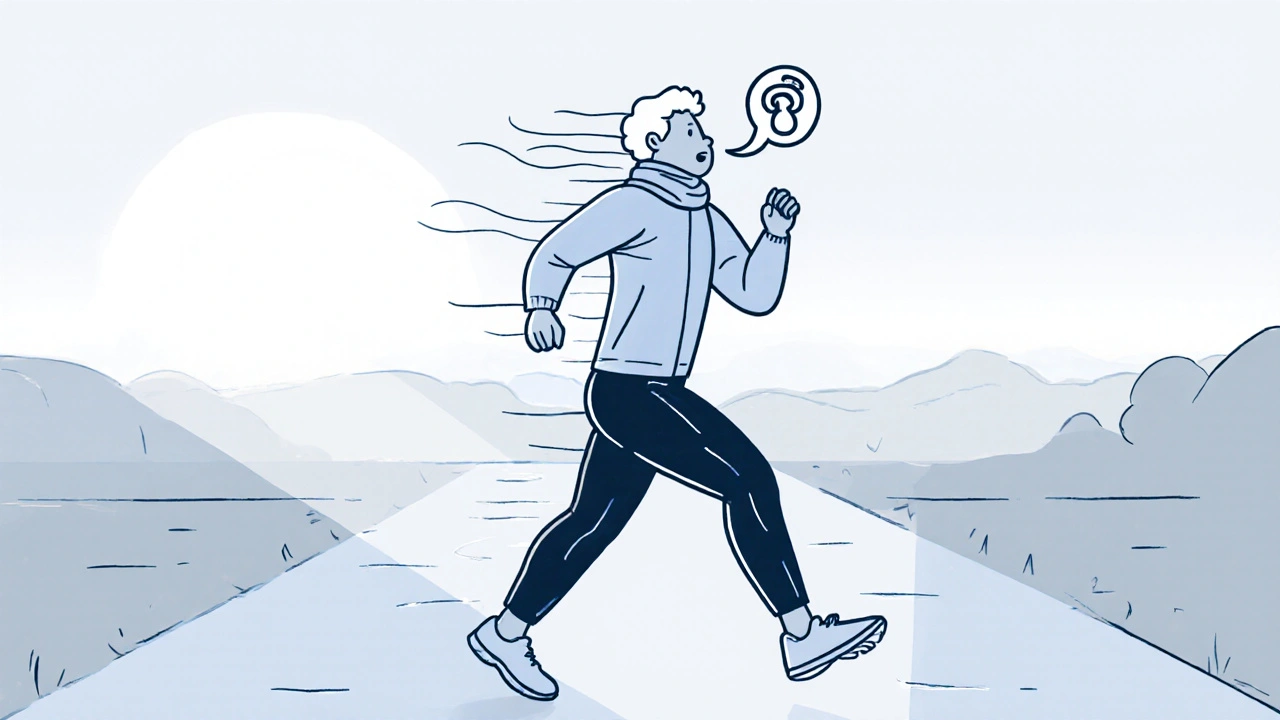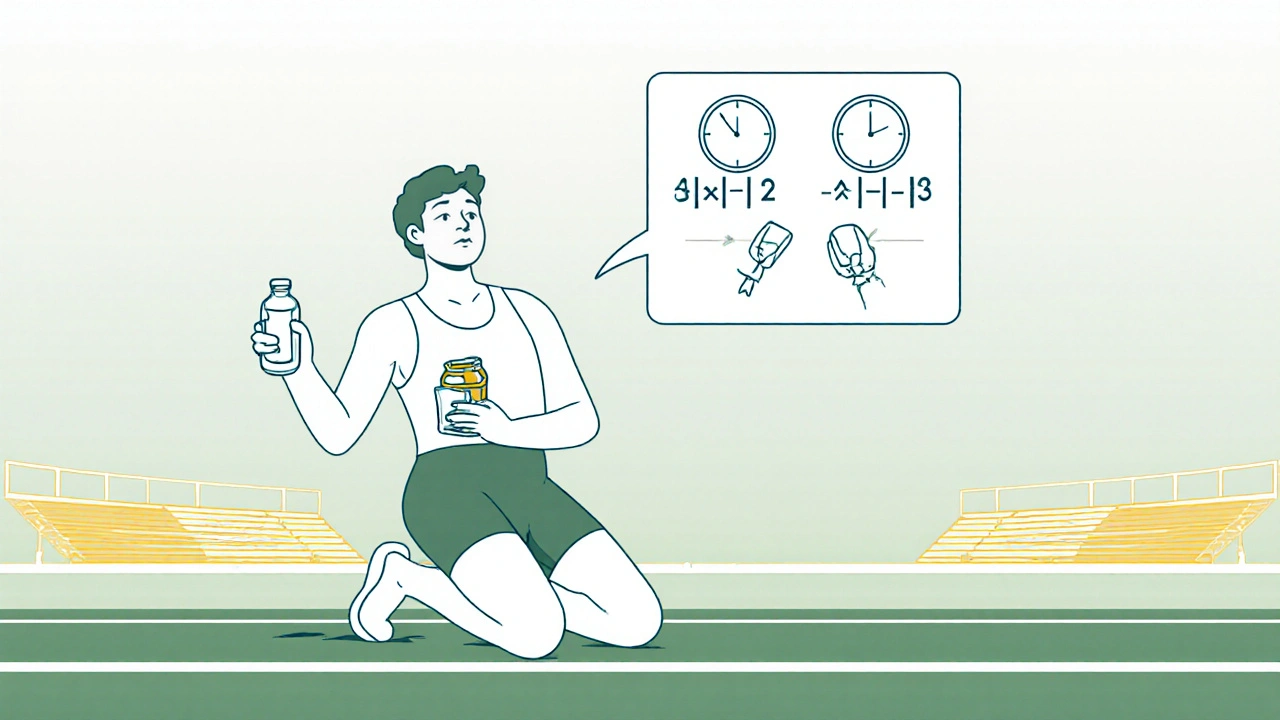
Cough Trigger Assessment Tool
Identify what might be causing your cough during exercise and get personalized recommendations based on your specific situation.
Quick Takeaways
- Identify the trigger - cold air, asthma, dehydration or infection.
- Pause, hydrate, and use a gentle breathing technique before deciding to continue.
- Natural remedies like honey or lozenges work for mild irritation; OTC suppressants are okay for short‑term use.
- If cough persists beyond a week, worsens, or comes with wheeze or chest pain, see a health professional.
- Build a pre‑exercise routine that includes proper warm‑up, nasal breathing, and post‑workout cool‑down to reduce future coughs.
Ever been mid‑run, feeling the wind in your lungs, when a sudden cough during sports knocks you off rhythm? It’s frustrating, especially when you’ve trained hard and just want to push through. The good news is that a cough while exercising isn’t always a sign of a serious problem, and with the right steps you can manage it without missing the next game.
Cough is a reflex that clears the airways of mucus, irritants, or foreign particles. During intense activity, the respiratory system works overtime, making it easier for anything from dry air to allergens to trigger that reflex. Understanding why the cough shows up is the first step to handling it smartly.
Why Coughs Happen When You’re Active
Three main factors conspire when you move:
- Airway irritation - Cold or dry air, pollen, or even dust from a gym floor can dry out the lining of the throat.
- Increased ventilation - You’re breathing faster and deeper, pulling more irritants into the lungs.
- Underlying conditions - Asthma, bronchial irritation, or a lingering upper‑respiratory infection can turn a normal breath into a cough trigger.
Because the body’s priority is oxygen delivery, the nervous system may overlook a mild irritation until the cough forces a reset. That’s why you often feel a “tightness” before the actual cough.
Immediate Steps: What to Do the Moment Cough Starts
When a cough interrupts a training session, the goal is to decide quickly whether you can safely keep going.
- Pause and assess. Stop for 30‑60 seconds. Note the cough’s intensity, frequency, and any accompanying wheeze or chest pain.
- Hydrate. Sip room‑temperature water or a sports drink. Fluids thin mucus and soothe the throat.
- Use a controlled breathing technique. Try the 2‑2‑2 pattern - inhale through the nose for two seconds, pause two seconds, exhale through the mouth for two seconds. This reduces airway turbulence.
- Apply a quick natural remedy. A teaspoon of honey or a menthol lozenge can coat the throat and suppress the reflex for up to 20 minutes.
If the cough subsides after these steps, you can resume at a lower intensity. If it persists, move to the next level of management.

Long‑Term Strategies to Keep Cough at Bay
Preventing the cough is easier than treating it mid‑session. Integrate these habits into your regular routine:
1. Optimize Hydration
Dehydration is a hidden cough trigger. Aim for 500 ml of fluid two hours before training and sip regularly during the workout. Electrolyte‑balanced drinks help replace salts lost through sweat, keeping the airway lining moist.
2. Warm‑Up With Nasal Breathing
A proper warm‑up gradually expands the bronchi. Start with 5‑10 minutes of low‑intensity activity while breathing solely through the nose. Nasal passages humidify and filter incoming air, reducing irritation.
3. Strengthen Respiratory Muscles
Incorporate diaphragmatic breathing drills and pursed‑lip exhalations into your off‑day routine. Stronger respiratory muscles mean less strain and fewer cough‑inducing spasms.
4. Manage Allergens and Air Quality
If you train outdoors in pollen season, wear a light mask or choose indoor sessions on high‑pollen days. Use a humidifier in indoor gyms during winter to combat dry air.
5. Schedule Regular Check‑Ups
Annual visits to a respiratory therapist or sports‑medicine physician can catch early signs of asthma or chronic bronchitis before they become performance‑limiting.
Safe Medications & Natural Remedies
When the cough is more than a brief annoyance, a short‑term remedy may be warranted. Below is a quick comparison of common options for athletes.
| Method | Onset | Benefits for Athletes | Potential Drawbacks |
|---|---|---|---|
| Honey (1 tsp) | 5‑10 min | Natural coating, no banned substances | Caloric, not suitable for infants |
| Menthol lozenge | 2‑5 min | Quick throat soothing, portable | May cause mild mouth irritation |
| OTC dextromethorphan | 15‑30 min | Effective cough suppressant, short‑term only | Can cause dizziness; check sport anti‑doping code |
| Inhaled bronchodilator (e.g., albuterol) | 1‑3 min | Relieves bronchial constriction, fast action | Prescription needed; possible tremor |
| Salt‑water gargle (½ tsp salt in 240 ml water) | 5‑10 min | Reduces throat inflammation, inexpensive | Requires time; may be uncomfortable for some |
Choose a remedy that fits the sport’s timing. For instance, a honey spoon works well before a morning run, while a lozenge can be kept in a pocket for quick relief during a match.
When to Pull Out and Seek Professional Help
Not every cough is harmless. Stop the activity and book an appointment if you notice any of the following:
- Chest pain or tightness that doesn’t ease with rest.
- Wheezing, shortness of breath, or a high‑pitched whistling sound.
- Cough lasting more than 10 days, especially if it produces discolored sputum.
- Fever above 38 °C (100.4 °F) accompanying the cough.
- Sudden loss of voice or difficulty swallowing.
These signs could point to bronchitis, pneumonia, or an exacerbated asthma condition-issues that need a clinician’s assessment and possibly prescription medication.
Checklist: Pre‑Game Cough Prevention Routine
- Check weather: If temperature < 5 °C, wear a breathable scarf over your mouth.
- Hydrate: Drink 300 ml of water 30 min before start.
- Warm‑up: 5 min of jogging with nasal breathing.
- Allergy scan: Take antihistamine if pollen count is high (consult your doctor first).
- Carry a small honey packet or lozenge for quick relief.
- Post‑activity cool‑down: 5 min of low‑intensity movement and a final sip of electrolyte drink.
Frequently Asked Questions
Can I use a cough suppressant during a marathon?
Yes, but only a short‑acting, non‑doping‑restricted type like dextromethorphan, and only if the cough is truly disruptive. Always check the sport’s anti‑doping regulations first.
Is honey safe for athletes who train at high intensity?
Honey provides a quick soothing effect without affecting performance. It’s safe for most adults; just watch the extra calories if you’re strict about energy intake.
Why does cold air make my cough worse?
Cold air dries the mucous membranes, causing irritation that triggers the cough reflex. Breathing through a mask or scarf warms and humidifies the air before it reaches the lungs.
Should I keep training if I have a mild post‑viral cough?
Mild, non‑productive coughs can often be continued at reduced intensity, but pay attention to fatigue and any new symptoms. If you notice worsening breathlessness, step back and rest.
Is a bronchodilator safe for occasional coughs?
Bronchodilators are prescription meds for asthma or bronchospasm. Using them without a diagnosis can mask underlying issues and cause side effects, so only use them under medical guidance.




4 Comments
Keep a water bottle handy and sip every few minutes.
While staying hydrated is undeniably beneficial, one must also consider electrolyte balance, especially during prolonged high‑intensity sessions; a mere water intake without sodium can actually exacerbate airway dryness, leading to an increased cough reflex, which defeats the purpose of the hydration strategy. Moreover, the temperature of the fluid matters-room‑temperature water is less likely to cause bronchial constriction than icy drinks. In addition, timing the sip to coincide with natural breathing pauses reduces turbulence in the airways, a nuance often overlooked in generic advice. Consequently, a comprehensive hydration plan should integrate electrolyte‑rich beverages, appropriate temperature, and strategic timing. Finally, remember that over‑hydration can be counterproductive, so moderation remains key.
The cough reflex is just the body’s way of saying, “hey, something’s off,” and it’s not always a sign of failure. In the grand scheme, a brief interruption doesn’t derail a training cycle, unless you let it. So, treat it as a momentary glitch, not a catastrophe. Keep moving when the symptom is mild, and only pause when it genuinely hinders performance.
Honestly, the idea of popping a cough suppressant mid‑marathon sounds like a shortcut for the lazy, and it borders on cheating when anti‑doping rules are bleeding edge. If you truly want to test your limits, you should embrace the natural cough and let it teach you about breath control. Medicine is a crutch, not a performance enhancer, and relying on it erodes the very grit athletes prize.